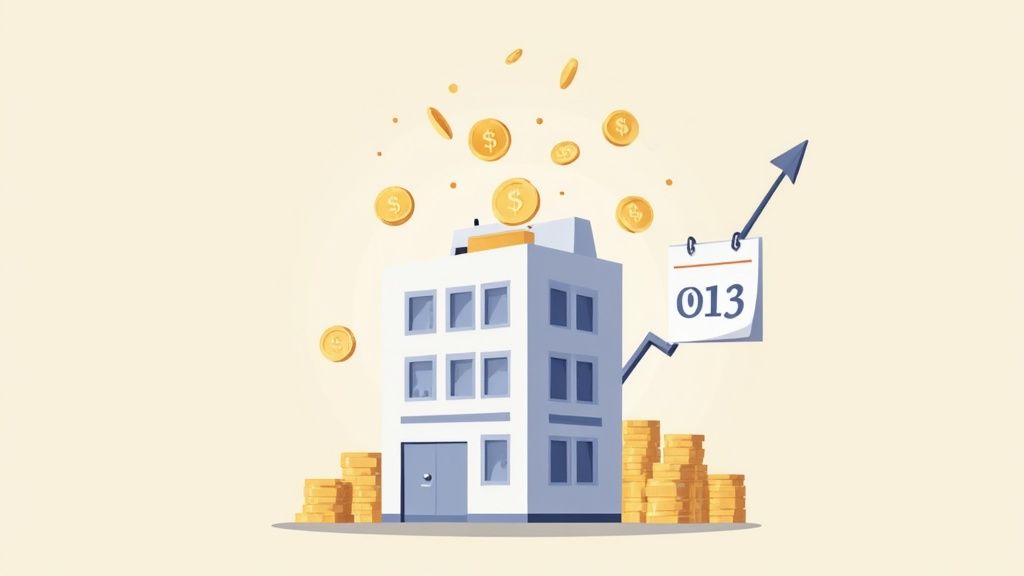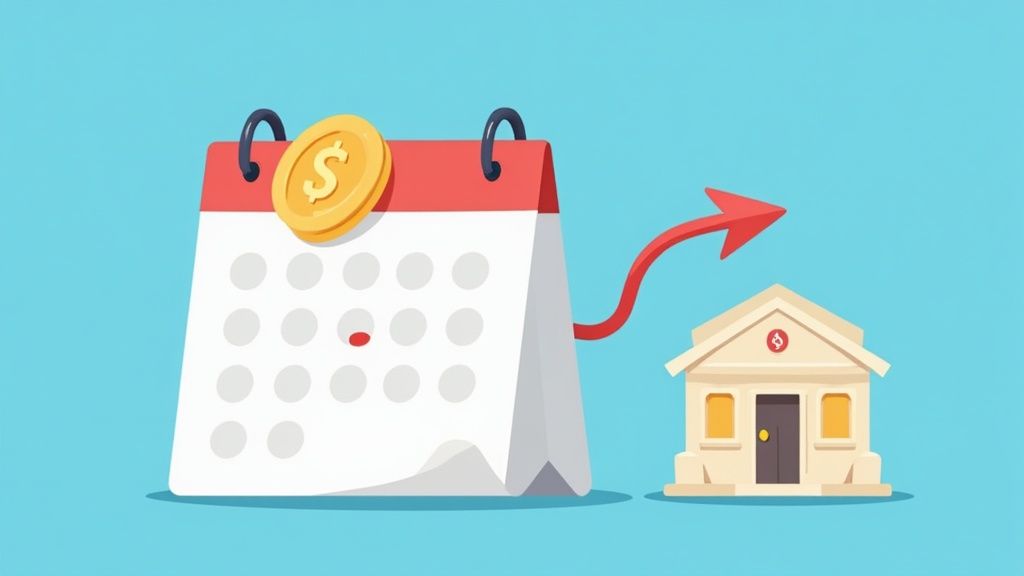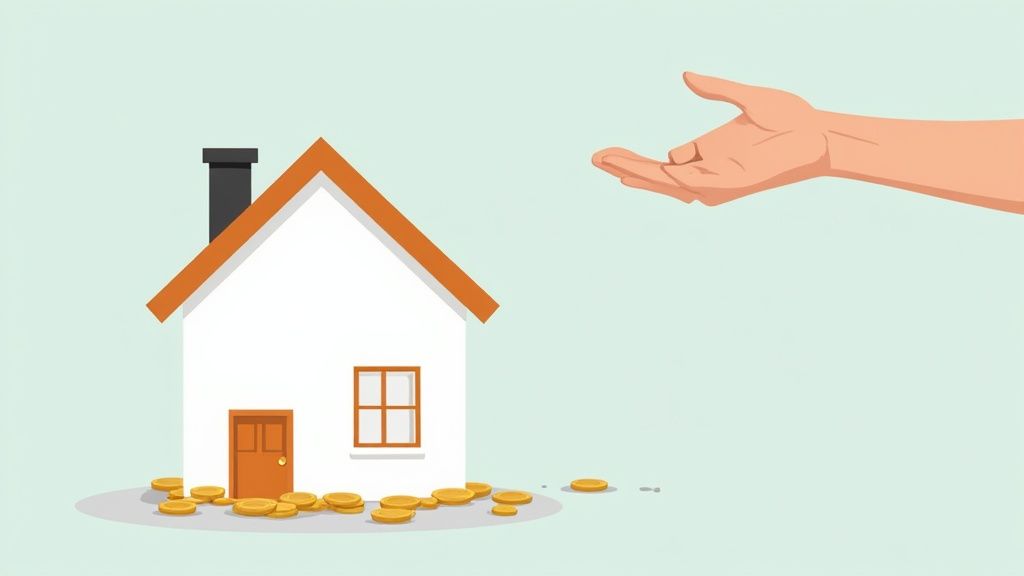Your Guide to the Realty Income Dividend
Explore the Realty Income dividend, from its monthly payouts and history to its business model. Learn how to analyze this popular REIT for your portfolio.

The Realty Income dividend is exactly what it sounds like: a consistent, monthly cash payment sent to shareholders of Realty Income Corporation (stock ticker: O). The company, famously trademarked as "The Monthly Dividend Company®," generates this cash from the rent it collects across its massive portfolio of commercial properties.
What Is the Realty Income Dividend

Think of it this way: imagine you owned a tiny slice of thousands of well-known commercial buildings—places like your local Walgreens, Dollar General, or 7-Eleven. Every month, when those tenants pay their rent, you'd get your cut. That's precisely what owning a share of Realty Income and receiving its dividend feels like.
It’s a straightforward way for everyday investors to tap into the steady cash flow of commercial real estate without the headache of actually buying and managing a building themselves.
Realty Income is structured as a Real Estate Investment Trust (REIT), and that structure is key. By law, REITs must distribute at least 90% of their taxable income back to shareholders as dividends. In exchange, the company itself pays very little in corporate income tax. This unique model is the engine that powers the reliable Realty Income dividend, making it a cornerstone for countless income-focused investors.
For a quick overview, here are the essential characteristics of Realty Income's dividend.
Realty Income Dividend At a Glance
This table captures why so many investors rely on Realty Income for steady, predictable cash flow month after month.
A Benchmark for Monthly Passive Income
For decades, investors searching for dependable passive income have gravitated toward Realty Income. The company hasn't just paid dividends consistently—it has increased them for over 25 consecutive years, earning it the prestigious title of "Dividend Aristocrat."
This incredible track record makes it a benchmark for other income-producing assets.
The appeal is its beautiful simplicity and reliability. Most companies pay dividends quarterly, but Realty Income’s monthly schedule is a game-changer for many investors, helping them:
- Cover monthly expenses: The regular payout aligns perfectly with real-world bills and budgets.
- Reinvest more frequently: Compounding your dividends monthly instead of quarterly can seriously accelerate wealth building over time.
- Gain psychological comfort: There’s nothing quite like seeing that cash hit your account every single month. It’s a tangible sign of progress.
This approach is a core part of building a passive income machine. If you're just getting started, getting the fundamentals right is critical. You can learn more by checking out a complete guide to dividend investing for beginners to build that solid foundation.
At its core, the Realty Income dividend transforms the complex world of commercial real estate into a simple, accessible stream of monthly income for everyday investors.
This model also adds a defensive quality to a portfolio. Realty Income’s tenants are often in resilient, non-discretionary industries—think convenience stores and pharmacies—that tend to do well no matter what the broader economy is doing. Before we dive deeper into the mechanics, just remember this one concept: Realty Income is a landlord on a massive scale, and as a shareholder, you get your slice of the rent checks every single month.
How Realty Income Funds Its Monthly Dividend

The consistency behind the Realty Income dividend isn't magic. It's built on a remarkably simple and durable business model. At its core, Realty Income is a massive landlord with a portfolio of over 15,450 commercial properties spread across the United States, Puerto Rico, and Europe.
But this isn't just a random collection of buildings. It's a strategically assembled group of assets leased to some of the most dependable tenants you can imagine. Think about the businesses you see every day: your local pharmacy, the neighborhood convenience store, or a nearby dollar store. These are the kinds of recession-resistant businesses that fill Realty Income's portfolio, ensuring rent gets paid no matter what the economy is doing. That predictable rental income is what directly funds those monthly dividend checks.
The Power of the Net Lease Agreement
The real secret to this stability lies in a specific type of contract: the net lease agreement.
Imagine owning a rental house where the tenant not only pays rent but also covers all the property taxes, insurance, and maintenance costs. That’s essentially what a net lease does for commercial properties. This model is a game-changer for Realty Income, as it insulates the company from the unpredictable costs that come with owning property.
This creates an incredibly predictable stream of cash flow. Better yet, most of these leases are incredibly long-term, often lasting 10 to 20 years with rent increases already baked in.
Here’s why this is so critical for funding the dividend:
- Predictable Revenue: Long-term leases mean Realty Income knows, with a high degree of certainty, how much rent is coming in for years to come.
- Reduced Operating Costs: Tenants handle most of the property-related expenses, protecting Realty Income’s profit margins.
- Built-in Growth: Contractual rent increases provide a slow but steady path for revenue to grow over time.
This combination of reliable tenants and low-maintenance lease structures forms the bedrock of the monthly dividend. The cash flows in like clockwork, allowing the company to distribute it to investors just as reliably.
Understanding Funds From Operations
When you look at a typical company, you might check its "net income" or "earnings per share" to see how profitable it is. For a REIT like Realty Income, though, those metrics can be seriously misleading. Why? Because of an accounting rule called depreciation.
Real estate accounting requires companies to deduct depreciation—a non-cash charge that assumes buildings lose value over time. But in the real world, well-maintained properties often appreciate. This accounting quirk can make a perfectly healthy REIT look far less profitable than it actually is. That’s where a much better metric, Funds From Operations (FFO), comes in.
FFO is the standard for measuring a REIT's cash-generating ability. It starts with net income and adds back non-cash expenses like depreciation and amortization, providing a clearer picture of the actual cash available to pay dividends.
Think of FFO as the true cash flow from the real estate business. It’s the money left over from collecting rent after all the operating expenses are paid. By focusing on FFO, you get a much more accurate sense of whether the Realty Income dividend is sustainable. For REIT investors, FFO is the number that truly matters.
Analyzing the Dividend's History of Growth

Past performance is never a guarantee of future results—we’ve all heard that disclaimer. But when it comes to dividend investing, history tells a powerful story about a company's reliability and its core philosophy. Looking at the Realty Income dividend isn't just about a few good years; it's like reading a multi-decade saga of consistency and commitment to shareholders.
That track record is everything. It's built on a simple but powerful promise: deliver a dependable, growing stream of monthly income. Realty Income has kept that promise with a discipline few companies ever achieve, earning it a spot in one of Wall Street's most exclusive clubs.
Earning the Title of Dividend Aristocrat
Realty Income is a proud member of the S&P 500 Dividend Aristocrats index. This isn't a title you can buy or stumble into. It’s reserved for S&P 500 companies that have increased their dividend for at least 25 consecutive years.
Think about that for a second. Consider all the economic chaos we've seen in the last quarter-century—the dot-com bust, the 2008 financial crisis, a global pandemic. Through it all, Realty Income didn't just keep paying its dividend; it gave its shareholders a raise. Every. Single. Year.
This achievement speaks volumes about the company's underlying strengths:
- A Resilient Business Model: Its net-lease structure with high-quality tenants keeps predictable cash flowing, even when the economy gets rocky.
- Disciplined Financial Management: The leadership team prioritizes a strong balance sheet and a sustainable payout ratio to make sure those dividends are secure.
- A Shareholder-First Culture: A 25+ year streak of increases proves that rewarding investors isn't an afterthought—it's baked into the company's DNA.
This elite status is far more than a badge of honor. It's a tangible signal of stability and a testament to the durability of the business model that funds the monthly checks investors count on.
A Track Record of Consistent Growth
But the company doesn't just maintain its dividend; it actively grows it. A quick look at the numbers shows a clear pattern of steady, methodical increases. Back in 2012, Realty Income paid out an annual dividend of around $1.4867 per share. Fast forward to 2024, and that figure has climbed to about $3.133 per share.
That’s not a get-rich-quick explosion. It’s the slow, steady, and predictable growth that income investors prize most. This is about building a reliable income stream that quietly outpaces inflation over the long haul. You can dig into the specifics yourself on sites like DividendMax.com.
Realty Income’s dividend history is a masterclass in compounding. Since going public in 1994, the company has declared 651 consecutive common stock monthly dividends and has increased that dividend 126 times.
These numbers are the ultimate proof of concept. They show an unwavering commitment to its nickname, "The Monthly Dividend Company®." For anyone sizing up the Realty Income dividend, this long and storied history provides a powerful foundation of trust and predictability—making it a true cornerstone for building a durable passive income portfolio.
Key Metrics for Evaluating the Dividend

To really get a feel for the health and appeal of the Realty Income dividend, you have to look past its impressive history and dig into the numbers. While there are plenty of metrics out there, two are absolutely essential for any serious dividend investor: the dividend yield and the payout ratio.
Master these two concepts, and you’ll have the tools to see not just what Realty Income is paying now, but whether it can keep the checks coming. Let’s break them down.
Dividend Yield: The Annual Return on Your Investment
First up is the dividend yield, probably the most popular metric for income investors. Think of it as the annual return you get from dividends, shown as a percentage of the stock's current price. It answers a simple, crucial question: "For every dollar I invest today, how much cash will I get back in dividends over the next year?"
The calculation is pretty straightforward:
Dividend Yield = (Annual Dividend Per Share / Current Share Price) x 100
For example, if a stock pays an annual dividend of $3.00 and is trading at $50.00 per share, the dividend yield is a solid 6%. This little percentage makes it easy to compare the income potential of different investments at a glance.
A higher yield can mean more income, but it's not the whole story. A sky-high yield can sometimes be a warning sign of higher risk, so context is key. For Realty Income, the yield has historically been a reflection of its commitment to consistent monthly payouts. As of recently, the company sports an annual dividend yield of around 5.49%, with an annual dividend per share of $3.23. This means for every $100 you invest, you could expect about $5.49 in annual dividend income, cementing its role as a steady income provider.
Payout Ratio: The Secret to REIT Sustainability
Next, we have the payout ratio, a critical measure of a dividend's safety. For most companies, you calculate it by dividing the dividends paid by the company's net income. A ratio below 100% usually signals the dividend is sustainable. Anything over 100% is a major red flag—it means the company is paying out more than it earns.
But this is where REITs like Realty Income play by a different set of rules.
As we covered earlier, net income is a poor metric for REITs because of big non-cash deductions like depreciation. If you were to look up Realty Income’s payout ratio based on its net income, you might see a figure well over 100% and start to panic. For a REIT, however, this is perfectly normal and not a sign of danger.
The right way to judge a REIT’s payout ratio is by using Funds From Operations (FFO), not net income.
- Traditional Payout Ratio (Misleading for REITs): Dividends / Net Income
- REIT Payout Ratio (The Right Way): Dividends / Funds From Operations (FFO)
Using FFO gives you a much clearer picture of the actual cash available to cover the dividend. For a healthy REIT, you want to see an FFO payout ratio somewhere between 70% and 85%. This sweet spot shows the company is easily funding its dividend with cash from its operations while still keeping enough capital to maintain its properties and grow its portfolio. This is the metric that truly tells you if the Realty Income dividend is built to last.
Understanding the Tax Implications
That steady Realty Income dividend is a fantastic way to generate passive income, but it's crucial to know how those monthly checks are handled at tax time. The rules for REITs aren't the same as for most other stocks, and getting a handle on the specifics can make a big difference to your after-tax returns.
The main distinction comes down to how dividends are classified. When a typical company like Apple or Coca-Cola pays a dividend, it's often a "qualified dividend." These get taxed at the more favorable long-term capital gains rates. But since REITs like Realty Income don't pay corporate income tax themselves, their distributions are usually treated as "non-qualified" dividends.
This means they’re generally taxed as ordinary income, right alongside your salary, which can be a much higher rate. It’s not a penalty, though. It’s just a consequence of the REIT structure, which requires them to pass at least 90% of their taxable income directly to shareholders. The tax obligation simply shifts from the corporation to you, the investor.
Return of Capital Explained
Now and then, a piece of your Realty Income dividend might be classified as a "return of capital" (ROC). Think of this not as a profit distribution, but as the company handing you back a small piece of your original investment.
When this happens, that portion of the payment isn't taxed right away. Instead, it lowers your cost basis—what you originally paid for your shares. For instance, if you bought a share for $50 and get $1 in ROC, your new cost basis for that share is $49. You only pay capital gains tax on that dollar when you eventually sell the stock. To get deeper into the weeds on this, check out our guide on dividend vs. return of capital.
The Best Strategy for REIT Dividends
So, how do you make the most of the Realty Income dividend, given its tax treatment? By far, the smartest move is to hold your REIT shares inside a tax-advantaged retirement account.
Holding REITs in a tax-advantaged account like a Traditional IRA, Roth IRA, or 401(k) is one of the smartest moves an income investor can make. It allows your monthly dividends to grow and compound without being eroded by annual taxes.
Here’s why that’s so powerful:
- Traditional IRA/401(k): Your dividends are tax-deferred. You won't pay a cent of tax on them year after year, letting your investment snowball much faster. You only pay taxes when you take the money out in retirement.
- Roth IRA/401(k): This is the holy grail. Your dividends grow completely tax-free. Since you funded the account with after-tax money, qualified withdrawals in retirement are not taxed at all. Zero.
Using these accounts effectively neutralizes the non-qualified dividend issue. For those with higher incomes, weaving Realty Income into a broader plan might involve specific tax strategies for high-income earners. You can certainly hold these shares in a regular taxable brokerage account, just be ready for a bigger tax bill on that monthly income come April.
Is Realty Income a Good Fit for Your Portfolio
So, we've unpacked the mechanics, the history, and the numbers behind the Realty Income dividend. Now for the big question: does it actually belong in your portfolio?
There's no single right answer here. It all comes down to your financial goals, how much risk you're comfortable with, and what you need your money to do for you.
Realty Income isn't a high-flying tech stock that's going to double overnight. Think of it less like a flashy sports car and more like a dependable sedan—it’s built for a smooth, steady ride, not for speed. That focus makes it a fantastic choice for a specific kind of investor.
Who Benefits Most from Realty Income
Every investor’s situation is unique, but certain financial profiles just click with what Realty Income brings to the table. You might find it’s a great fit if you're:
- An Income-Seeker in Retirement: If you need to supplement Social Security or a pension, that reliable monthly dividend check can be a lifesaver for covering bills and enjoying your retirement.
- A Defensive Investor: Worried about market swings? Realty Income's long track record of weathering economic storms can offer some serious peace of mind when volatility spikes.
- A Long-Term Compounding Enthusiast: For younger investors, those monthly payouts are perfect for reinvesting. It’s a classic "set it and forget it" way to let the power of compounding build wealth over decades.
Of course, picking one stock is just a small piece of the puzzle. Building a successful income portfolio starts with understanding how to choose the right dividend stocks for your own specific needs.
Weighing the Pros and Cons
Like any investment, Realty Income isn't perfect. To make a smart call, you have to weigh the good against the bad. Picture a financial scale: on one side, you have stability; on the other, growth potential. Does the balance align with your goals?
The core trade-off with the Realty Income dividend is crystal clear: you are swapping the chance for rapid growth for the benefit of high-quality, consistent monthly income.
If your main goal is to build a reliable stream of passive income from a company with a stellar history of rewarding its shareholders, Realty Income makes a very strong case.
But if you’re chasing maximum gains and have a high tolerance for risk, you’ll probably want to look elsewhere. By thinking through these points, you can decide what role, if any, this monthly dividend machine should play in your financial future.
Frequently Asked Questions
Even after you've got the business model down, a few common questions always seem to pop up. Let's tackle them head-on to clear up any lingering doubts you might have about the Realty Income dividend.
How Safe Is the Realty Income Dividend?
This is probably the single most famous thing about Realty Income—its rock-solid dividend. The stability isn't an accident; it's built on a foundation of long-term net leases with high-quality, often investment-grade tenants in industries that tend to hold up well even when the economy gets rocky. This structure is designed to generate highly predictable cash flow, which is exactly what funds those monthly checks to shareholders.
On top of that, its status as a Dividend Aristocrat—with over 25 consecutive years of raising the dividend—is a powerful testament to its commitment and ability to navigate all sorts of economic storms. While no dividend is ever 100% guaranteed, Realty Income’s track record and conservative business model make it one of the most dependable income streams you can find on the market.
What Are the Biggest Risks to the Dividend?
As solid as it is, no investment is without risk, and it pays to know what they are. The biggest one for a REIT like Realty Income is interest rate risk. Think of it this way: Realty Income often competes with bonds for investors' money. When interest rates climb, the relatively safe yield on bonds starts looking more attractive, which can put downward pressure on Realty Income’s stock price.
Other risks to keep an eye on include:
- Tenant Defaults: If a major economic downturn hits hard, even strong tenants could struggle to pay rent. This would directly impact the cash flow available to pay out as dividends.
- Real Estate Market Downturns: A significant slump in commercial real estate could make it harder for the company to grow or manage its properties as effectively as it has in the past.
Realty Income has a long history of managing these risks well, but they are part of the deal when you invest in the real estate sector. It’s crucial to keep them in mind.
Can the Realty Income Dividend Keep Growing?
History tells us that slow and steady growth is baked into the company's DNA. Realty Income has a very disciplined strategy of buying new properties that immediately add to its Funds From Operations (FFO)—the key metric that fuels dividend payments.
This methodical expansion, combined with built-in rent increases in its existing leases, creates a clear path for future growth. Don't expect explosive dividend hikes. Instead, the entire business is engineered to deliver small, consistent increases over the long haul, helping your passive income stream keep pace with or even beat inflation over time.
Ready to stop guessing and start seeing the full picture of your investments? PinkLion offers a unified dashboard to track your entire portfolio, including real-time dividend income and cash flow projections. Connect your broker accounts automatically and use our AI-powered tools to forecast your portfolio's future and stress-test your strategy. Take control of your financial journey and start tracking your investments for free with PinkLion.
